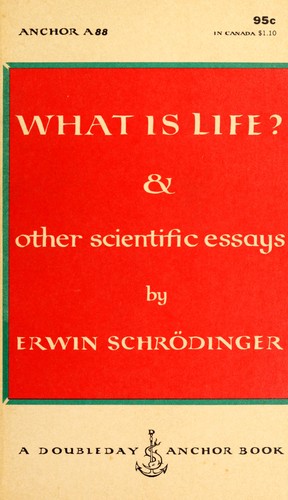Erwin Rudolf Josef Alexander Schrödinger (UK: , US: ; German: [ˈɛɐ̯viːn ˈʃʁøːdɪŋɐ]; 12 August 1887 – 4 January 1961), sometimes written as Erwin Schrodinger or Erwin Schroedinger, was a Nobel Prize-winning Austrian-Irish physicist who developed a number of fundamental results in quantum theory: the Schrödinger equation provides a way to calculate the wave function of a system and how it changes dynamically in time. In addition, he wrote many works on various aspects of physics: statistical mechanics and thermodynamics, physics of dielectrics, colour theory, electrodynamics, general relativity, and cosmology, and he made several attempts to construct a unified field theory. In his book What Is Life? Schrödinger addressed the problems of genetics, looking at the phenomenon of life from the point of view of physics. He paid great attention to the philosophical aspects of science, ancient, and oriental philosophical concepts, ethics, and religion. He also wrote on philosophy and theoretical biology. In popular culture, he is most known for his "Schrödinger's cat" thought experiment. Schrödinger's personal life caused him some problems as he lived with both a wife and mistress. In his journal, he also documented sexual liaisons with other women and his self-described "predilection for teenage girls". Spending most …
Erwin Schrödinger
Author details
- Born:
- Jan. 4, 1887
- Died:
- Jan. 4, 1961
External links
Erwin Rudolf Josef Alexander Schrödinger (UK: , US: ; German: [ˈɛɐ̯viːn ˈʃʁøːdɪŋɐ]; 12 August 1887 – 4 January 1961), sometimes written as Erwin Schrodinger or Erwin Schroedinger, was a Nobel Prize-winning Austrian-Irish physicist who developed a number of fundamental results in quantum theory: the Schrödinger equation provides a way to calculate the wave function of a system and how it changes dynamically in time. In addition, he wrote many works on various aspects of physics: statistical mechanics and thermodynamics, physics of dielectrics, colour theory, electrodynamics, general relativity, and cosmology, and he made several attempts to construct a unified field theory. In his book What Is Life? Schrödinger addressed the problems of genetics, looking at the phenomenon of life from the point of view of physics. He paid great attention to the philosophical aspects of science, ancient, and oriental philosophical concepts, ethics, and religion. He also wrote on philosophy and theoretical biology. In popular culture, he is most known for his "Schrödinger's cat" thought experiment. Schrödinger's personal life caused him some problems as he lived with both a wife and mistress. In his journal, he also documented sexual liaisons with other women and his self-described "predilection for teenage girls". Spending most of his life as an academic with positions at various universities, Schrödinger along with Paul Dirac won the Nobel Prize in Physics in 1933 for his work on quantum mechanics, the same year he left Germany due to his opposition to Nazism. In his personal life, he lived with both his wife and his mistress which may have led to problems causing him to leave his position at Oxford. Subsequently, until 1938, he had a position in Graz, Austria until the Nazi takeover, when he fled finally finding a long-term arrangement in Dublin where he remained until retirement in 1955. He died in Vienna of tuberculosis at the age of 73.
